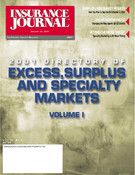Big things are happening up in little Grass Valley, Calif. A membership insurance group called Networked Insurance Agents (NIA) is building a network that allows agents to own their business and retain their independence while still utilizing the perks of belonging to a bigger organization.
NIA began as Lewis & Gregg Insurance Services in 1990, providing underwriting management for concrete pumpers and welding supply dealers, and writing these programs with its only insurance company, Transamerica Insurance Company. But in October 1993, Lewis & Gregg set a new course for itself and took on a new name, one that better illustrated the direction it was going: getting “networked.”
“We concluded that there was a niche to serve small premium-volume agents,” said Michael L. Lewis, NIA chairman and CEO. “The average agency is $5 million and below, which makes up 60 percent of valuable agencies in the U.S….We’re focusing on the agency that’s perceived as less sophisticated. We know they have their own direct appointments—we say keep those, we’ll fill around them. We’ll do the backroom.”
That backroom includes underwriting, marketing and customer service support. In 1994, with 200 affiliate agents in California, 20 company appointments and 18 employees, NIA dug in with its motto of “let them sell; let us provide service,” and the concept has paid off.
Today NIA has more than 60 appointments and a growing distribution network of more than 450 affiliates. Lewis said NIA is currently testing Oregon. “We have just gone into Oregon with one company, and we hope to go into other states in the next few years,” he said.
Roughly 78 employees go to work every day at NIA’s headquarters in Grass Valley. One question Lewis hears a lot is: “How do you get people up here?” Easily enough, he said. “We recruit through advertising and job listings—we’re big enough, we can make a job for the right employee.”
In 1998, NIA began to enforce its franchise concept by implementing a dues structure requiring a monthly membership fee of $125 rather than the previous semi-annual amount. “The franchise we’ve created is driven by dues rather than broker fees—we don’t charge broker fees ever,” Lewis said.
According to Lewis, NIA has four key components that contribute to its success:
1) Service to the local independent agency. “We offer their client preferred market choice…other agencies don’t have the preferred markets we have: Chubb, CNA, The Hartford—we stack the markets.”
2) Underwriting competency. Lewis said that in order to get profitable results and not just chase premium volume, agencies have to have an underwriter on staff, which can be expensive. NIA solves the problem with 20 full-time underwriters.
3) Value-added resources. “We’re driven by doing deals with various outside vendors [such as Applied],” Lewis said. “Over time our agencies may not need agency management systems—we will provide it.” NIA also gives a relatively low price on a comparative rater.
4) Technology. “The future is tied to becoming more seamless,” Lewis said. “By the first quarter of 2001, we want to be able to go into the site and access a Hartford quote, rate it and bind it online.” NIA plans to improve efficiency through its efforts with SEMCI and the electronic transfer and receipt of data, as well as its refinement of its computer and workflow systems.
“The key is stacking our markets so they are all available in a seamless way,” Lewis said. “Many markets don’t appoint small premium-volume agencies, but by stacking with us they can distribute their product.
“When you look at the marketplace, little agencies get squeezed—we’re the missing link between them and their markets.”
Topics Agencies
Was this article valuable?
Here are more articles you may enjoy.


 Adjusters Launch ‘CarFax for Insurance Claims’ to Vet Carriers’ Damage Estimates
Adjusters Launch ‘CarFax for Insurance Claims’ to Vet Carriers’ Damage Estimates  AIG Announces Strategic Investment Partnership of Up to $3.5B With CVC
AIG Announces Strategic Investment Partnership of Up to $3.5B With CVC  Grandson Not Covered Under Grandma’s Home Insurance
Grandson Not Covered Under Grandma’s Home Insurance  Allstate Can Proceed With Recovery in Texas RICO Case: Fifth Circuit
Allstate Can Proceed With Recovery in Texas RICO Case: Fifth Circuit 


